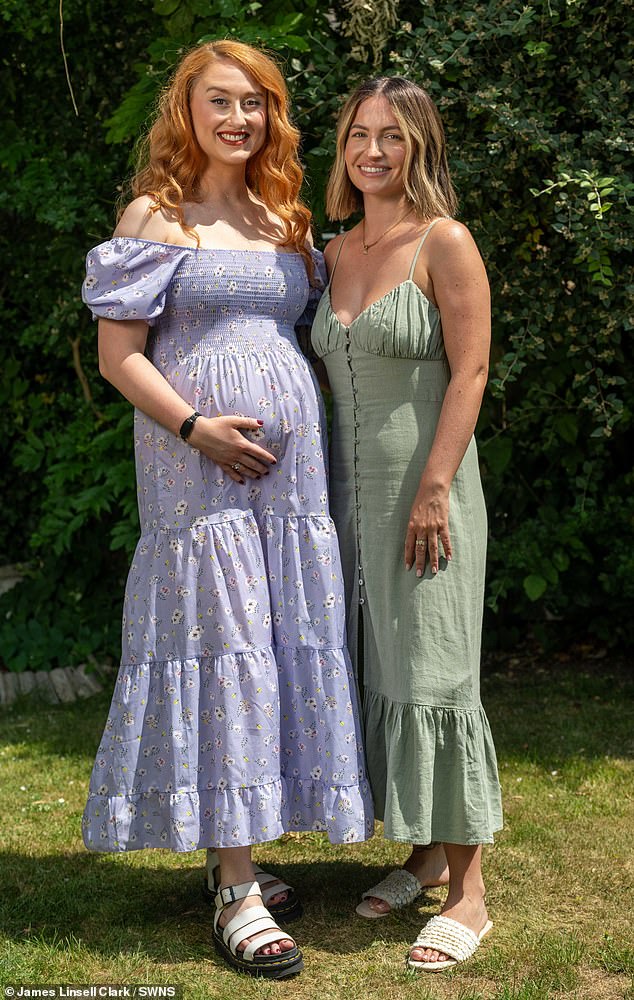Amum is urging Australians to take skin checks seriously after a terrifying brush with cancer that saw her diagnosed with nine melanomas – despite being dismissed by a senior GP who told her to ‘wait 12 months’.
Melissa Bates, 49, from Stroud in the New South Wales Hunter Region, had always considered herself sun smart.
She didn’t sunbake, wore protective clothing, and got annual check-ups.
As a theatre nurse with 16 years of experience, she thought she was doing everything right.
But at 43, during a routine visit to the doctor for her daughter’s cold, Melissa’s life changed.
‘I wasn’t even there for myself,’ she told FEMAIL.
‘The young GP registrar said he had some time to listen to my chest – because I also had a cold – and so I lifted my shirt up.
‘That’s when he noticed something on my back and said it looked really suspicious. He wanted to do a biopsy on the spot.’

A mum is urging Australians to take skin checks seriously after a terrifying brush with cancer that saw her diagnosed with nine melanomas

Melissa Bates, 49, from Stroud in the New South Wales Hunter Region, had always considered herself sun smart
Melissa asked for a second opinion from the senior GP at the practice who took a look and told her not to worry.
‘He told me it looked fine and to just get it checked in a year,’ she said.
Exhausted and sick with asthma, Melissa didn’t follow up.
It wasn’t until months later – after a cracked tooth while mountain bike riding landed her in town again – that the young doctor asked about the mole.
‘He was so persistent. He said, “I still feel really strongly about it”. So I finally agreed to the biopsy,’ Melissa recalled.
The result? Melanoma in situ – the earliest form of skin cancer, confined to the top layer of skin.
Left untreated, it could have progressed.
‘It was so lucky. That GP potentially saved my life,’ she said.


Melissa underwent a wide local excision on the melanoma on her back only to find the margins weren’t clear. More melanomas (left and right) appeared in the years that followed

Over the next several years, more melanomas appeared, one after another, all in situ, but each requiring surgery
Melissa underwent a wide local excision, only to find the margins weren’t clear – meaning not all of the melanoma had been removed.
She sought out a plastic surgeon in Newcastle, where she was urgently re-operated on in a clinic room due to long hospital waitlists.
Unfortunately, that first scare wasn’t the last.
Over the next several years, more melanomas appeared, one after another, all in situ, but each requiring surgery.
‘In the space of a few years, I had nine of them,’ Melissa said.
‘They kept appearing near the same spot on my back. And then, on my arm and leg. Every three months I’d go back to the doctor and have another part of me cut out.’
Despite no family history and a careful lifestyle, Melissa became a regular at skin clinics.
Her experience was so profound that she completed a postgraduate dermatology degree and now splits her week between the operating theatre and working in dermatology at John Hunter Hospital.

Over the next several years, more melanomas appeared, one after another, all in situ, but each requiring surgery

Despite no family history and a careful lifestyle, Melissa became a regular at skin clinics

As a single mum to daughters Isabel, 16, and Amelia, 14, Melissa admits her greatest fear was what would happen if her cancer had advance
‘Now I watch people’s skin like a hawk,’ she said.
‘I catch things all the time.’
But the experience also left emotional scars.
As a single mum to daughters Isabel, 16, and Amelia, 14, Melissa admits her greatest fear was what would happen if her cancer had advanced.
‘They were only eight and ten when I was first diagnosed. I remember thinking, “What if this gets worse? Who’s going to look after them? What happens to the farm, the animals, everything?”
‘I didn’t want to have to go through chemo or radiation. I didn’t want to die of something that could have been caught earlier.’
Now, more than two years melanoma-free, Melissa remains vigilant.
She checks her skin constantly, keeps a photographic record of any suspicious spots, and teaches her daughters sun safety ‘like it’s second nature’.

Her experience was so profound that she completed a postgraduate dermatology degree and now splits her week between the operating theatre and working in dermatology at John Hunter Hospital

Melissa nowchecks her skin constantly, keeps a photographic record of any suspicious spots, and teaches her daughters sun safety ‘like it’s second nature’
‘They wear hats, sunglasses, sunscreen – they’re educated and that’s key.’
She also credits mountain biking and a strong network of lifelong friends with helping her manage the mental toll.
‘It’s how I deal with the anxiety,’ she said.
‘That, and talking to my stepdad, who’s a GP. He was shocked when I kept getting melanomas. He’s all about statistics, and even he said my risk should’ve been almost zero.’
Melissa has changed GP clinics and has never returned to the senior doctor who told her to ‘wait and see’.
‘Take a photo. Right now. If you notice a spot, take a picture and compare it again in three months. Don’t wait,’ she advised.
‘Because I did – and I was lucky. But it could have been so much worse.’
Moshy Dermatologist Doctor Ludi Ge told FEMAIL year-round skin protection is more important than ever with winter a critical time to not only remain vigilant about skin health but a prime time to get your skin checked.

Melissa’s journey is a powerful reminder that even the most routine visit can become life-changing – and that listening to your gut, and to the right doctor, could save your life
‘In winter UV levels can reach 3 or higher, which is sufficient to cause skin damage and photo ageing, while the cumulative effect of daily exposure, even in cooler months, increases the risk of skin cancer,’ Doctor Ge said.
‘People often associate sunburn with heat, but UV rays penetrate clouds and can harm the skin regardless of temperature, even when driving in the car.
‘Skin cancers can appear in different forms including lesions like a mole or scab that won’t heal, bleeding on light contact, changes in size and colour and flat moles that become raised or develop an irregular edge.’
Australia has the highest melanoma rates in the world killing one Australian every six hours. It is the most common cancer in Australians aged 20-39.
Latest cancer data released by the Australian Institute of Health and Welfare (AIHW) shows melanoma incidence rates are still on the rise in Australia, with 70 cases per 100,000 people in 2024 – up from 53 per 100,000 in 2000.
‘While summer’s intense sun prompts caution seeing people actively applying sunscreen when they’re heading to the beach or playing sport, but in winter’s cooler climate it can lull people into a false sense of security and they forget to apply sunscreen or wear a hat,’ Dr Ge said.
‘When it comes to skin checks people need to be monitoring areas that don’t necessarily get the most exposure, including in between the fingers and toes, on the scalp and hairline, the soles of your feet and the abdomen.
‘Don’t let the cooler weather fool you, incorporating sun protection into your daily routine 365 days of the year and making skin checks an annual habit could save your life.’
Melissa’s journey is a powerful reminder that even the most routine visit can become life-saving – and that listening to your gut, and to the right doctor, has never been more important.










